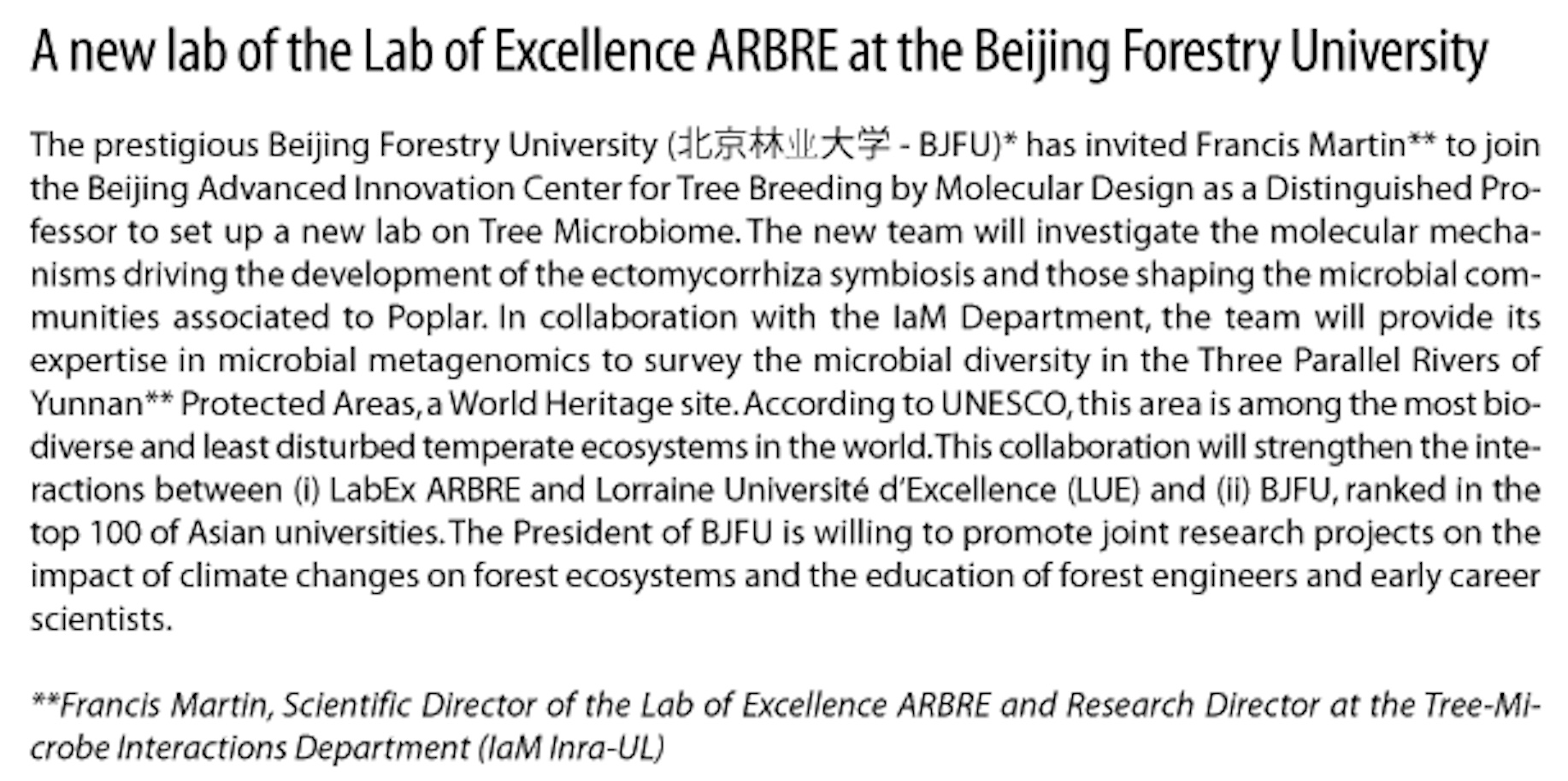 To register, follow this link …
To register, follow this link …
Author Archives: fmartin
A new lab of the Lab of Excellence ARBRE at the Beijing Forestry University


Underlying mechanisms linking forest productivity and diversity of tree species
Within the framework of Alexandre Fruleux’s PhD project, a new paper, available online at Oecologia, investigates the underlying mechanisms linking forest productivity and diversity of tree species.
Abstract: Aboveground overyielding in a mixed temperate forest is not explained by belowground processes
The relationship between forest productivity and tree species diversity has been described in detail, but the underlying processes have yet to be identified. One important issue is to understand which processes are at the origin of observed aboveground overyielding in some mixed forests. We used a beech–maple plantation exhibiting aboveground overyielding to test whether belowground processes could explain this pattern. Soil cores were collected to determine fine root (FR) biomass and vertical distribution. Correlograms were used to detect spatial arrangement. Near-infrared reflectance spectroscopy was used to identify the tree species proportion in the FR samples and spatial root segregation. An isotopic approach was used to identify water acquisition patterns. The structure and the composition of the ectomycorrhizal fungal community were determined by high-throughput sequencing of DNA in the soil samples. We found no spatial pattern for FR biomass or for its vertical distribution along the gradients. No vertical root segregation was found, as FR density for both species decreased with depth in a similar way. The two species displayed similar vertical water acquisition profiles as well, mainly absorbing water from shallow soil layers; hence, niche differentiation for water acquisition was not highlighted here. Significant alterations in the fungal community compositions were detected in function of the percentage of maple in the vicinity of beech. Our findings do not support the commonly suggested drivers of aboveground overyielding in species-diverse forests and suggest that competition reduction or between-species facilitation of belowground resource acquisition may not explain the observed aboveground overyielding.
3ème rencontre publique du projet « Extractibles des Forêts de l’Est »
 « EXTRAFOREST : les premiers résultats sur les écorces et les nœuds »
« EXTRAFOREST : les premiers résultats sur les écorces et les nœuds »
La rencontre aura lieu le jeudi 18 octobre 2018 de 9h00 à 12h40
dans l’Amphi A d’AgroParisTech Nancy (14 rue Girardet)
Seminar: Vanessa Haverd

Workshop BENCHAFOR
On October 2nd & 3rd, scientists from the ONF, INRA and DSF will discuss the current knowledge on the biology and ecology of cockchafers to explore novel options to limit the insect outbreaks and their detrimental impact on forest regenerations.
The common and forest Cockchafer are two beetle species well known for the damages they can inflict to forest ecosystems. Whereas the adults may occasion spectacular defoliations to adult trees, the larvae also feed on the roots of young trees causing severe mortality in forest regenerations, further impacting the whole forest management process. Eastern European countries had been facing recurrent infestations since the 1960’s; in France, cockchafer populations seem to have turned from endemic to epidemic in the last 10 years, with dramatic damages reported in young forest stands of Picardie and Northern Alsace. In Germany, chemical treatments proved to be efficient in reducing populations and subsequent damages but their use is now forbidden. A wide diversity of alternatives had been investigated in Europe, mainly based on biological control methods. To date, these studies did not produce results that could be developed and ultimately applied in everyday forest management.
Forest managers now question the opportunity of modifying forest ecosystem parameters that are critical for the different phases of the cockchafer lifecycle. Such actions are likely to produce short-term efficient methods with limited environmental impacts. This project is based on a benchmarking approach of the acquired scientific knowledge of cockchafer biology and of thetechnical experiences accumulated in the European countries that have been subjected to outbreaks in the last decades. We aim at investigating whether changes in silvicultural management are able to limit cockchafer population dynamics.
Our first objective is to establish a state-of-the-art review of the knowledge concerning the environmental factors which determine cockchafer outbreaks. Then, our second objective is to propose a protocol to describe stand cover structure and ground vegetation characteristics which determine cockchafer larval density. These two objectives will initiate national and international networking on the research for solutions to cockchafer damages to forests.
Finally, the proposed project will provide a framework of hypothesis for the research of ecological solutions to prevent cockchafer outbreaks. This innovative project is likely to initiate a technical and scientific strategy for the management crisis caused by cockchafer outbreaks.
LabEx Seminar : Johannes Breidenbach

Seminar: From molecules to the Globe

Opened position for the CiTIQUE project

#MT180
Congratulations to Nathalie Carol for her award, 1st Audience Prize, during the “My Thesis in 180 s“ competition at the University of Lorraine. She did a great job in describing her joint LabEx ARBRE project with the National Forest Service, AgroParisTech, INRA and University of Lorraine.



